l-Arginine as a Bio-Based Curing Agent for Epoxy Resins: Glass Transition Temperature, Rheology and Latency
Abstract
:1. Introduction
2. Materials and Methods
2.1. Materials
2.2. Sample Preparation
2.3. Sample Storage
2.4. Characterization Methods
3. Results and Discussion
3.1. Differential Scanning Calorimetry
3.2. Viscosity
4. Conclusions
Author Contributions
Funding
Acknowledgments
Conflicts of Interest
References
- Schürmann, H. Konstruieren Mit Faser-Kunststoff-Verbunden; Springer: Berlin/Heidelberg, Germany, 2007. [Google Scholar]
- Lengsfeld, H.; Wolff-Fabris, F.; Krämer, J.; Lacalle, J.; Altstädt, V. Faserverbundwerkstoffe—Prepregs und Ihre Verarbeitung; Hanser Publishers: Munich, Germany, 2014. [Google Scholar] [CrossRef] [Green Version]
- Bourne, L.; Milner, F.; Alberman, K. Health problems of epoxy resins and amine–curing agents. Am. J. Ind. Med. 1959, 16, 81–97. [Google Scholar] [CrossRef] [PubMed] [Green Version]
- Greim, H.; Bury, D.; Klimisch, H.J.; Oeben-Negele, M.; Ziegler-Skylakakis, K. Toxicity of aliphatic amines: Structure-activity relationship. Chemosphere 1998, 36, 271–295. [Google Scholar] [CrossRef]
- Venables, K. Low molecular weight chemicals, hypersensitivity, and direct toxicity: The acid anhydrides. Br. J. Ind. Med. 1989, 46, 222–232. [Google Scholar] [CrossRef] [PubMed]
- Anku, W.; Mamo, M.; Govender, P. Phenolic Compounds in Water: Sources, Reactivity, Toxicity and Treatment Methods; IntechOpen: London, UK, 2017. [Google Scholar] [CrossRef] [Green Version]
- Ghasemi, S.; Sibi, M.; Ulven, C.; Webster, D.; Pourhashem, G. A Preliminary Environmental Assessment of Epoxidized Sucrose Soyate (ESS)-Based Biocomposite. Molecules 2020, 25, 2797. [Google Scholar] [CrossRef] [PubMed]
- Leuchtenberger, W.; Huthmacher, K.; Drauz, K. Biotechnological production of amino acids and derivatives: Current status and prospects. Appl. Microbiol. Biotechnol. 2005, 69, 1–8. [Google Scholar] [CrossRef]
- Nelson, D.; Cox, M. Lehninger Principles of Biochemistry; MacMillan Learning: New York City, NY, USA, 2021. [Google Scholar]
- Larsen, P. 6-Physical and Chemical Properties of Amino Acids; Academic Press: London, UK, 1980. [Google Scholar] [CrossRef]
- Li, Y.; Xiao, F.; Wong, C. Novel, Environmentally Friendly Crosslinking System of an Epoxy Using an Amino Acid: Tryptophan-Cured Diglycidyl Ether of Bisphenol A Epoxy. J. Polym. Sci. Part A Polym. Chem. 2007, 45, 181–190. [Google Scholar] [CrossRef]
- Motahari, A.; Omrani, A.; Rostami, A. Theoretical study on the mechanism of epoxy cured with tryptophan in the presence of 2,4,5-triphenylimidazole as a catalyst. Comput. Theor. Chem. 2011, 977, 168–180. [Google Scholar] [CrossRef]
- Mazzocchetti, L.; Merighi, S.; Benelli, T.; Giorgini, L. Evaluation of Tryptophan—Late curing agent systems as hardener for epoxy resin. In AIP Conference Proceedings; AIP Publishing LLC: Melville, NY, USA, 2018. [Google Scholar] [CrossRef]
- Merighi, S.; Mazzocchetti, L.; Benelli, T.; Giorgini, L. Evaluation of Novel Bio-Based Amino Curing Agent Systems for Epoxy Resins: Effect of Tryptophan and Guanine. Processes 2021, 9, 42. [Google Scholar] [CrossRef]
- Motahari, A.; Rostami, A.; Omrani, A.; Ehsani, M. On the Thermal Degradation of a Novel Epoxy-Based Nanocomposite Cured With Tryptophan as an Environment-Friendly Curing Agent. J. Macromol. Sci. Part B Phys. 2015, 54, 517–532. [Google Scholar] [CrossRef]
- Shibata, M.; Fujigasaki, J.; Enjoji, M.; Shibita, A.; Teramoto, N.; Ifuku, S. Amino acid-cured bio-based epoxy resins and their biocomposites with chitin- and chitosan-nanofibers. Eur. Polym. J. 2018, 98, 216–225. [Google Scholar] [CrossRef]
- Chiu, Y.C.; Huang, C.C.; Tsai, H.C.; Prasannan, A.; Toyoko, I. Effect of aromatic and aliphatic amines as curing agents in sulfone epoxy monomer curing process. Polym. Bull. 2013, 70, 1367–1382. [Google Scholar] [CrossRef]
- Utagawa, T. Production of Arginine by Fermentation. J. Nutr. 2004, 134, 2854–2857. [Google Scholar] [CrossRef] [Green Version]
- Gnanasekar, P.; Yan, N. Synthesis and thermo-mechanical properties of novel spirobiindane based epoxy nanocomposites with tryptophan as a green hardener: Curing kinetics using model free approach. Polym. Degrad. Stab. 2019, 163, 110–121. [Google Scholar] [CrossRef]
- Li, Y.; Xiao, F.; Moon, K.; Wong, C. Novel Curing Agent for Lead-Free Electronics: Amino Acid. J. Polym. Sci. Part A Polym. Chem. 2005, 44, 1020–1027. [Google Scholar] [CrossRef]
- Raetzke, K.; Shaikh, M.; Faupel, F.; Noeske, P.L. Shelf stability of reactive adhesive formulations: A case study for dicyandiamide-cured epoxy systems. Int. J. Adhes. Adhes. 2010, 30, 105–110. [Google Scholar] [CrossRef]
- Hübner, F.; Meuchelböck, J.; Wolff-Fabris, F.; Mühlbach, M.; Altstädt, V.; Ruckdaeschel, H. Fast curing unidirectional carbon epoxy prepregs based on a semi-latent hardener: The influence of ambient aging on the prepregs Tg0, processing behavior and thus derived interlaminar performance of the composite. Compos. Sci. Technol. 2021, 216, 109047. [Google Scholar] [CrossRef]
- Blass, D.; Kreling, S.; Dilger, K. The impact of prepreg aging on its processability and the postcure mechanical properties of epoxy-based carbon-fiber reinforced plastics. Proc. Inst. Mech. Eng. Part L J. Mater. Des. Appl. 2017, 231, 62–72. [Google Scholar] [CrossRef]
- Bethke, C.; Goller, S.M.; Ngoc, U.L.D.; Kaysser, S.T.; Altstädt, V.; Ruckdäschel, H. Tailoring Epoxy Resin Foams by Pre-Curing with Neat Amine Hardeners and Its Derived Carbamates. Polymers 2021, 13, 1348. [Google Scholar] [CrossRef]
- Hutschreuther, J.; Kunz, R.; Breu, J.; Altstädt, V. Influence of Particle Size on Toughening Mechanisms of Layered Silicates in CFRP. Materials 2020, 13, 2396. [Google Scholar] [CrossRef]
- Olowojoba, G. Assessment of Dispersion Evolution of Carbon Nanotubes in Shear-Mixed Epoxy Suspensions by Interfacial Polarization Measurement. Ph.D. Thesis, Karlsruhe Institute of Technology (KIT), Karlsruhe, Germany, 2013. [Google Scholar]
- Tanaka, Y.; Bauer, R. Curing Reactions. In Epoxy Resins—Chemistry and Technology; Springer: Berlin/Heidelberg, Germany, 1988; pp. 285–464. [Google Scholar]
- Hayaty, M.; Honarkar, H.; Beheshty, M.H. Curing behavior of dicyandiamide/epoxy resin system using different accelerators. Iran. Polym. J. 2013, 22, 591–598. [Google Scholar] [CrossRef]
- Liu, X.D.; Kimura, M.; Sudo, A.; Endo, T. Accelerating effects of N-aryl-N’,N’-dialkyl ureas on epoxy-dicyandiamide curing system. J. Polym. Sci. Part A Polym. Chem. 2010, 48, 5298–5305. [Google Scholar] [CrossRef]
- Güthner, T.; Hammer, B. Curing of epoxy resins with dicyandiamide and urones. J. Appl. Polym. Sci. 1993, 50, 1453–1459. [Google Scholar] [CrossRef]
- LaLiberte, B.R.; Bornstein, J.; Sacher, R.E. Cure behavior of an epoxy resin-dicyandiamide system accelerated by monuron. Ind. Eng. Chem. Prod. Res. Dev. 1983, 22, 261–262. [Google Scholar] [CrossRef]
- Pfitzmann, A.; Fischer, A.; Fryauf, K.; Fedtke, M. Curing of epoxy resins by dicyandiamide. Polym. Bull. 1992, 27, 557–564. [Google Scholar] [CrossRef]
- Gilbert, M.D. Mechanism and Kinetics of the Dicyandiamide Cure of Epoxy Resins. Ph.D. Thesis, University of Massachusetts Amherst, Amherst, MA, USA, 1988. [Google Scholar]
- Chursova, L.; Tkachuk, A.; Panina, N.; Gurevich, Y.; Babin, A.; Malkov, G. A study of the mechanism of curing of the dicyandiamide-epoxydiane oligomer system in the presence of asymmetrical urea. Polym. Sci. Ser. D 2015, 8, 153–162. [Google Scholar] [CrossRef]
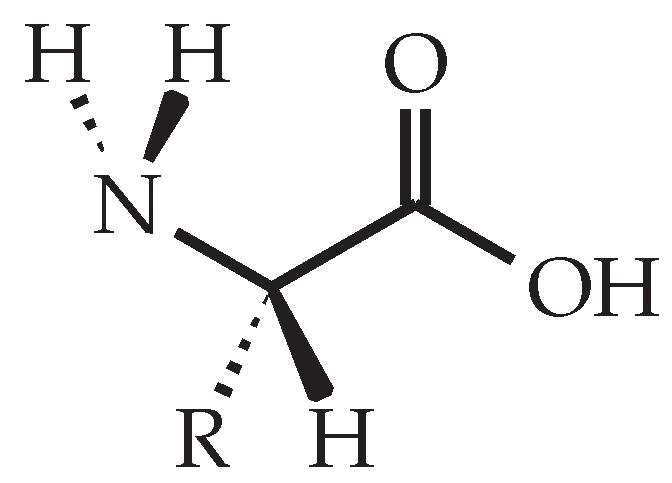

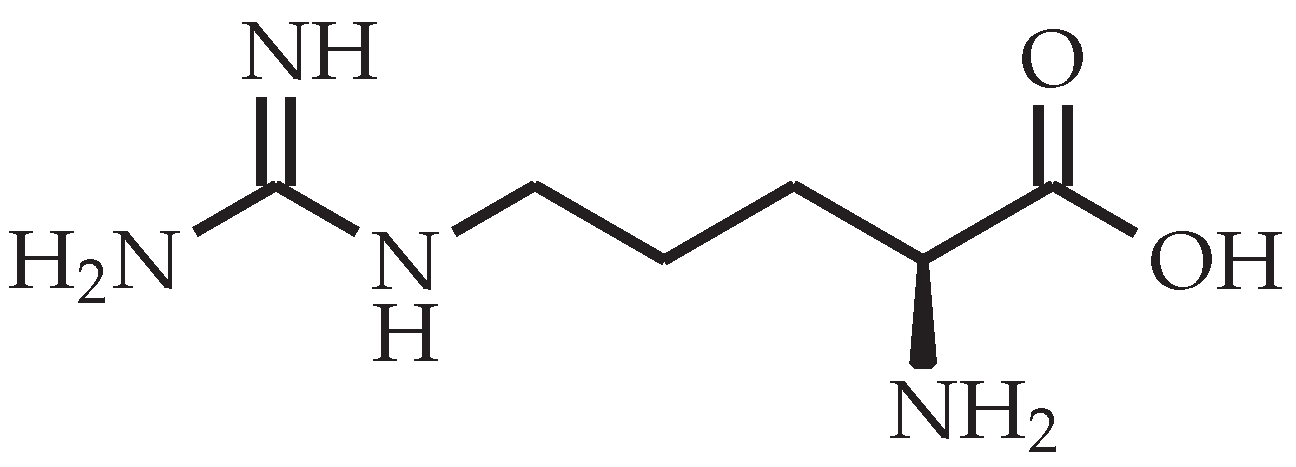
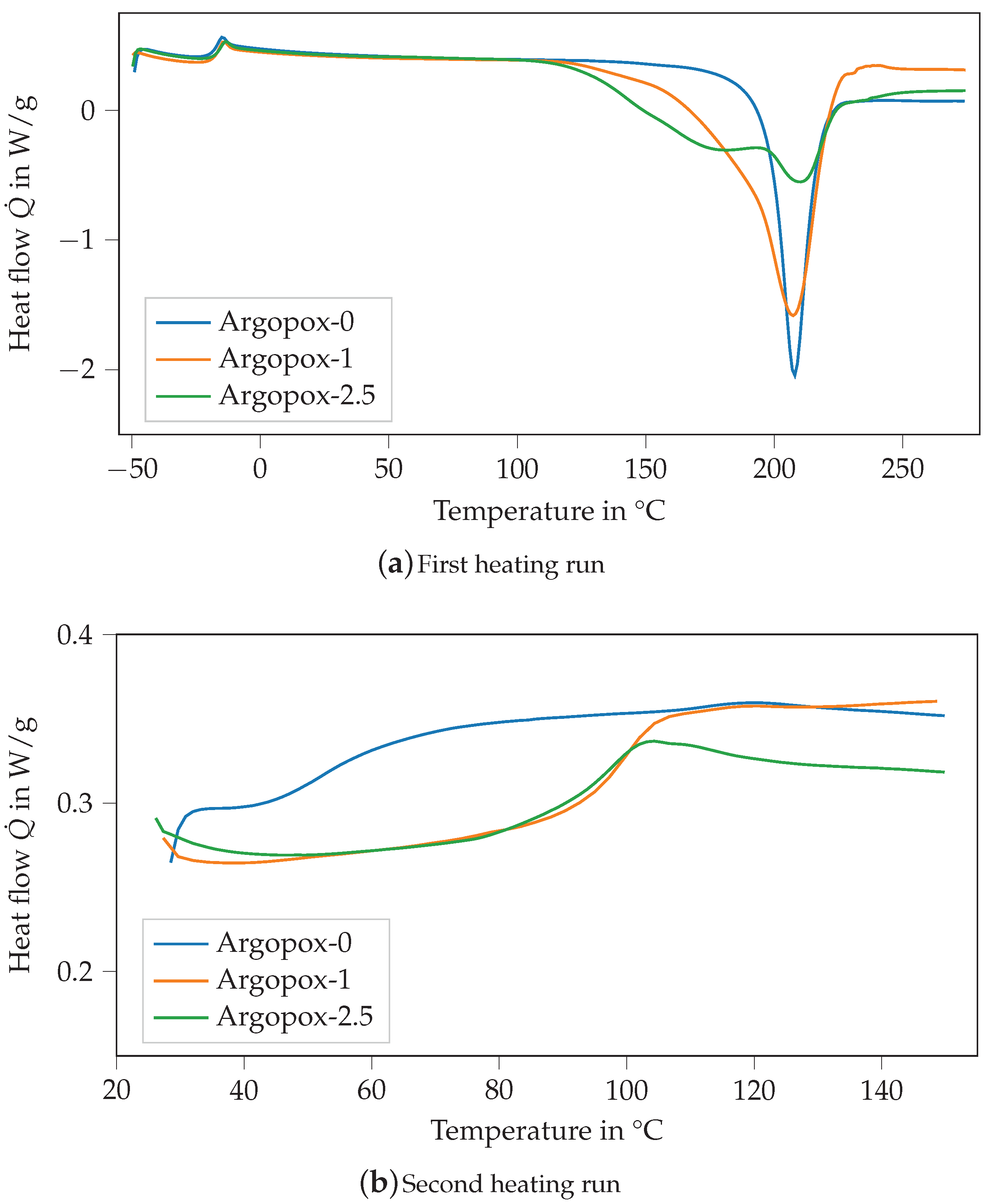
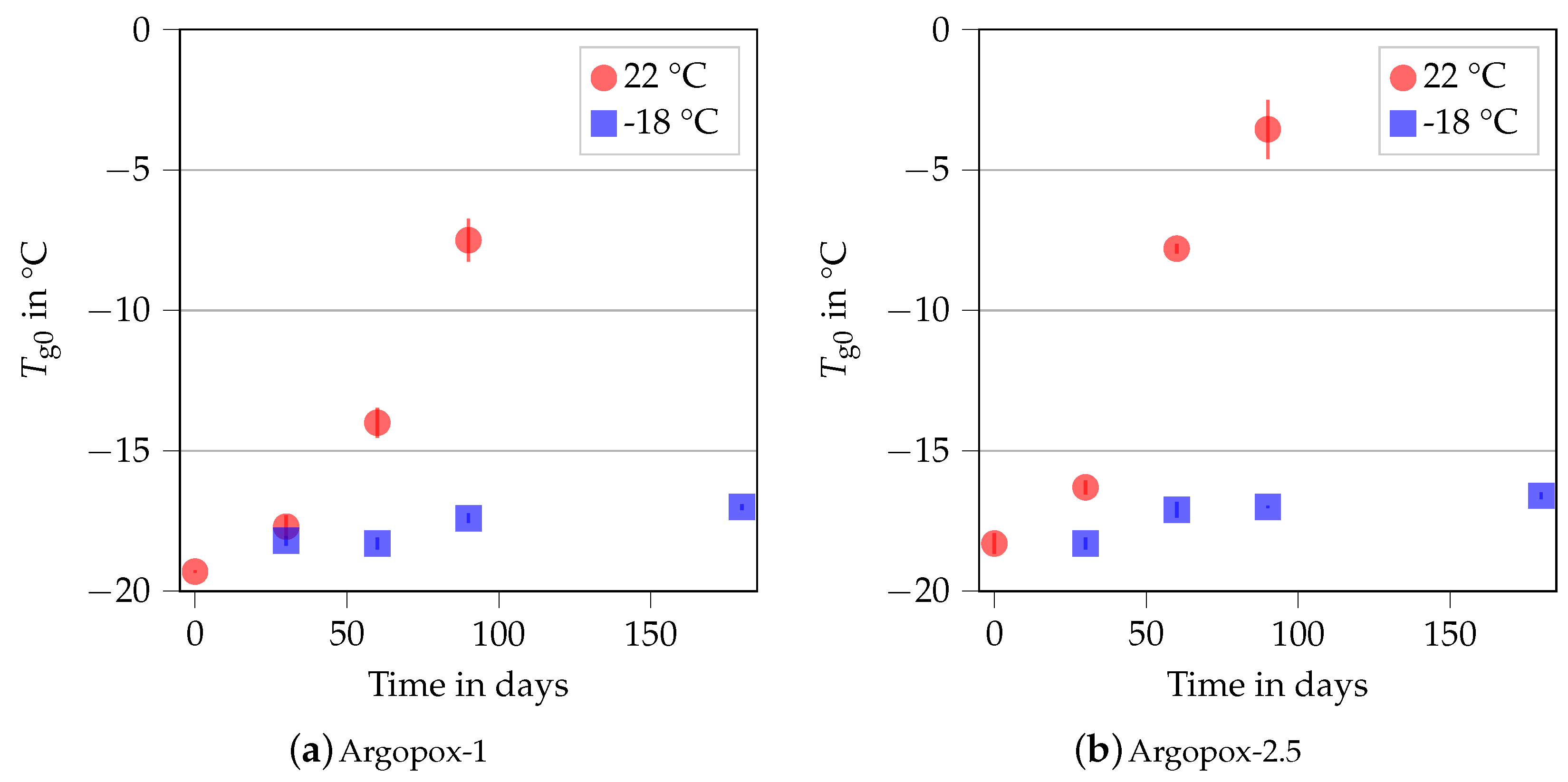




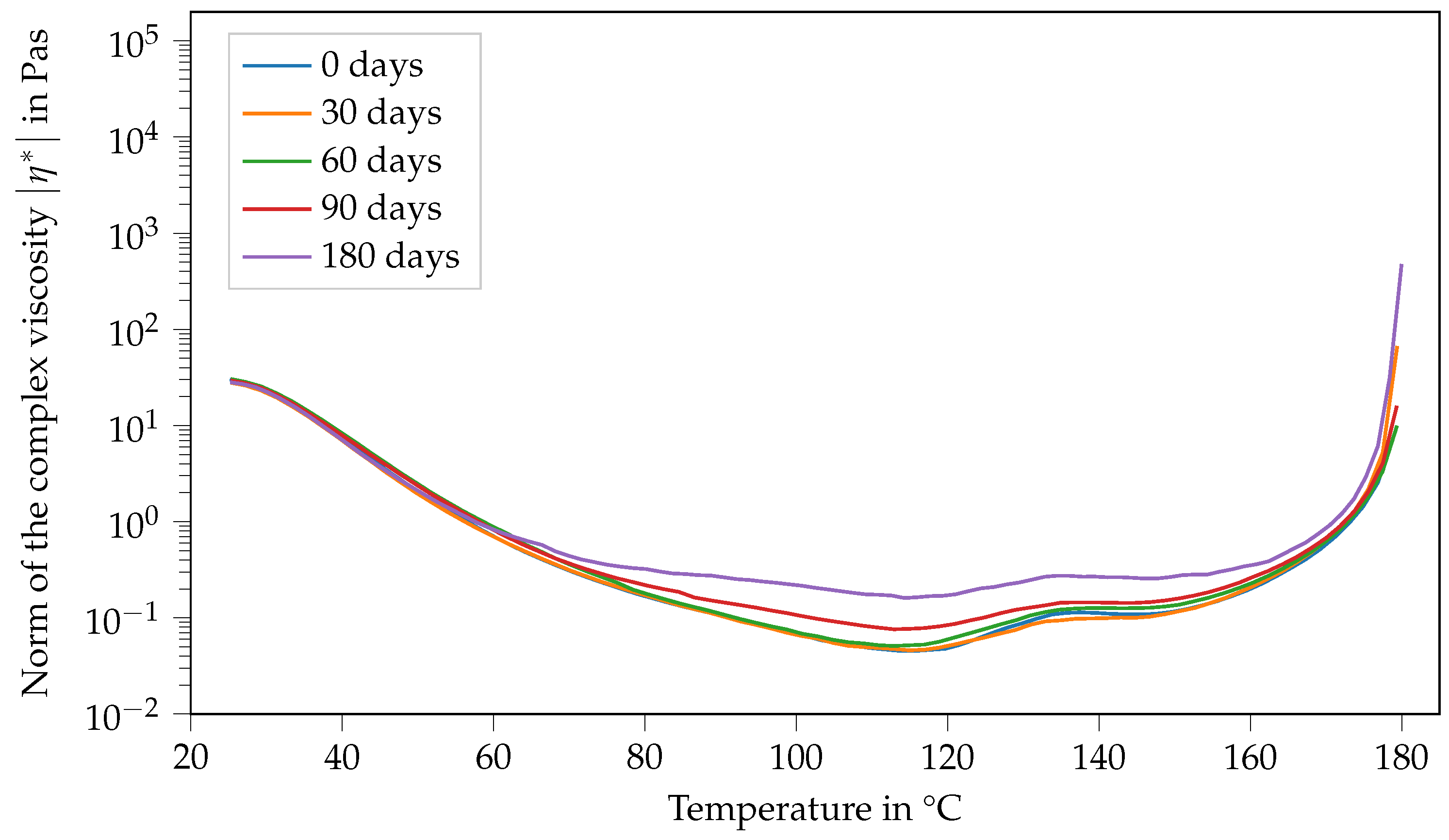
| Component | Argopox-1 | Argopox-2.5 |
|---|---|---|
| D.E.R. 331 | ||
| l-arginine | ||
| DYHARD® UR500 | 1 |
Publisher’s Note: MDPI stays neutral with regard to jurisdictional claims in published maps and institutional affiliations. |
© 2022 by the authors. Licensee MDPI, Basel, Switzerland. This article is an open access article distributed under the terms and conditions of the Creative Commons Attribution (CC BY) license (https://creativecommons.org/licenses/by/4.0/).
Share and Cite
Rothenhäusler, F.; Ruckdaeschel, H. l-Arginine as a Bio-Based Curing Agent for Epoxy Resins: Glass Transition Temperature, Rheology and Latency. Polymers 2022, 14, 4331. https://doi.org/10.3390/polym14204331
Rothenhäusler F, Ruckdaeschel H. l-Arginine as a Bio-Based Curing Agent for Epoxy Resins: Glass Transition Temperature, Rheology and Latency. Polymers. 2022; 14(20):4331. https://doi.org/10.3390/polym14204331
Chicago/Turabian StyleRothenhäusler, Florian, and Holger Ruckdaeschel. 2022. "l-Arginine as a Bio-Based Curing Agent for Epoxy Resins: Glass Transition Temperature, Rheology and Latency" Polymers 14, no. 20: 4331. https://doi.org/10.3390/polym14204331






